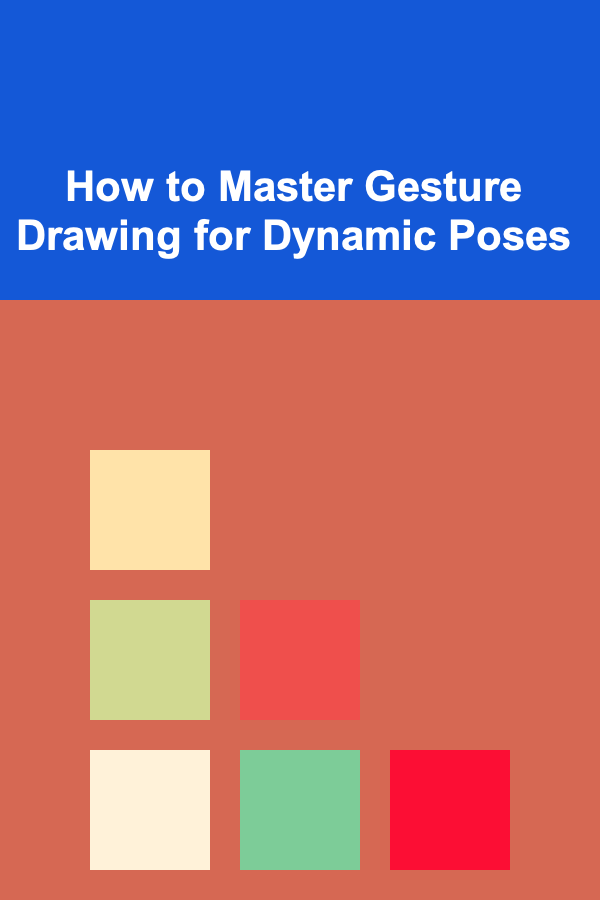
How to Master Gesture Drawing for Dynamic Poses
ebook include PDF & Audio bundle (Micro Guide)
$12.99$10.99
Limited Time Offer! Order within the next:

Gesture drawing is one of the most vital techniques in figure drawing, especially when it comes to capturing dynamic, expressive poses. Whether you are an aspiring artist, a seasoned illustrator, or simply someone passionate about improving their drawing skills, mastering gesture drawing will help you breathe life into your work. It allows you to capture the essence of movement, energy, and emotion, all while focusing on the core structure of the human body.
In this guide, we will explore the nuances of gesture drawing for dynamic poses, the fundamentals behind it, and how you can refine your skills to improve your drawings. From the importance of understanding anatomy to the techniques used to convey action and motion, this article will give you the tools to enhance your artistic abilities and unlock the power of gesture drawing.
What is Gesture Drawing?
Gesture drawing refers to the process of quickly sketching the basic action, movement, and energy of a subject, often a figure or a person, with minimal detail. The goal is not to create a finished piece but rather to capture the gesture---the underlying essence of the figure's motion. Gesture drawings are typically done in a short time frame (ranging from a few seconds to a few minutes), allowing the artist to focus on the big picture and avoid getting bogged down in intricate details.
The Importance of Gesture in Art
The human body is a complex and dynamic structure, and when drawing, it is easy to fall into the trap of focusing solely on proportions, details, and symmetry. While these are important, understanding gesture is crucial to making your work feel alive and natural. By mastering gesture, you can create drawings that not only look accurate but also convey the movement and emotion that make a figure truly compelling.
Gesture drawing serves as the foundation for more detailed artwork. It is the framework upon which you can later add flesh, muscle, and intricate details to bring the figure to life. It's the first step in creating believable and dynamic human figures, whether they are standing still, dancing, or caught in mid-motion.
The Fundamentals of Gesture Drawing
Before diving into dynamic poses, it's essential to understand the core principles that will guide your gesture drawings. The following elements are the pillars of effective gesture drawing:
1. Line of Action
The line of action is the invisible curve that represents the primary flow of the body's movement. This line often runs through the spine and defines the overall direction and energy of the figure. It helps to unify the drawing and gives it a sense of rhythm. The line of action is essential for dynamic poses, as it allows you to capture the force behind the pose and make your drawing more fluid and energetic.
- Tips for the Line of Action: When starting a gesture drawing, begin with a simple curve or straight line to represent the line of action. This will guide the rest of your drawing and give you a roadmap for how the figure should move.
2. Simplification of Shapes
In gesture drawing, you want to avoid getting bogged down with fine details. Instead, break the body down into simple, basic shapes like circles, ovals, and lines. These shapes represent the major masses of the body and are key to understanding how the body moves and interacts in space.
- Tips for Simplification: Start with basic shapes such as an oval for the torso, a circle for the head, and lines for the limbs. These shapes are placeholders that help you focus on the pose's energy rather than getting distracted by details like fingers or facial features.
3. Proportions and Anatomy
Although gesture drawing focuses on capturing the overall motion and energy, it is essential to understand the basic proportions of the human body. A strong understanding of human anatomy will allow you to depict the body's movement accurately, even in dynamic poses.
- Tips for Proportions: Learn the general proportions of the human figure (e.g., the body is typically 7-8 heads tall). Understanding these proportions will allow you to sketch dynamic poses more realistically while keeping the figure's proportions in check.
4. Rhythm and Flow
Rhythm and flow are key to creating dynamic gesture drawings. Just like music, movement has a rhythm---a flow that creates a natural, continuous progression. Every action, whether it's a person running, jumping, or simply stretching, has a flow that dictates the way the body moves.
- Tips for Rhythm and Flow: Visualize the rhythm of the movement before you start drawing. Think of the human figure as a series of fluid motions, with each part of the body working in harmony. Let the drawing flow from the start to the end, rather than focusing on static details.
Techniques for Dynamic Poses
Now that we've covered the fundamentals, let's dive deeper into the techniques that will help you master gesture drawing for dynamic poses.
1. Start with Action Poses
To master dynamic gestures, you need to draw from life or reference images of people in action. Whether you're drawing athletes, dancers, or just regular people in motion, practicing with action poses will help you learn how to capture energy and motion effectively.
- Tips for Action Poses: Look for references that emphasize movement---think of poses that involve stretching, twisting, or jumping. These kinds of dynamic poses will push you to understand the body's weight distribution, balance, and movement.
2. Use Quick Studies (Timed Gestures)
Timed gesture drawing is an excellent way to hone your skills and push yourself to think quickly. Set a timer for each sketch (typically 30 seconds to 5 minutes) and focus solely on capturing the basic movement of the figure, without worrying about details.
- Tips for Timed Gestures: Start with quick, loose lines to map out the flow of the pose. Don't worry about the details; instead, focus on the shape, direction, and energy of the pose. Over time, your ability to capture the essence of the pose in a short amount of time will improve.
3. Focus on Contrapposto and Weight Distribution
Contrapposto is an Italian term that refers to the natural stance in which a figure's weight is placed on one leg, causing a slight twist in the body. This natural, relaxed stance is commonly seen in standing poses and is key to understanding dynamic motion.
- Tips for Contrapposto: Pay attention to how the figure's weight is shifted onto one leg. The opposite leg will usually be relaxed, and the hips and shoulders may twist slightly. This will help your figures feel more natural and dynamic, rather than stiff or posed.
4. Capture Action with Diagonal Lines
Dynamic poses often involve a lot of angles and diagonal lines. These lines add tension, energy, and movement to the figure, making it appear more active and less rigid. Using diagonal lines in your gesture drawings can make a huge difference in how energetic the pose appears.
- Tips for Diagonal Lines: Look for the diagonals that emerge in a pose. For example, if a figure is jumping or twisting, the limbs may create diagonal lines as they stretch out. Incorporating these diagonals will make the drawing feel more active and dramatic.
5. Experiment with Foreshortening
Foreshortening is a technique used to create the illusion of depth by altering the size and proportions of an object or figure based on its position in space. When done correctly, foreshortening can make dynamic poses feel even more intense and dramatic.
- Tips for Foreshortening: When drawing foreshortened figures, pay close attention to how parts of the body change in size. For example, a raised arm or leg will appear larger and closer to the viewer, while the rest of the body may recede into the background. This creates a sense of depth and perspective.
6. Focus on the Silhouette
The silhouette of a pose is the most important factor in determining its impact. A strong, clear silhouette can communicate the movement and energy of the figure without needing excessive detail. Look for the primary shapes in the pose and ensure they are readable from a distance.
- Tips for Silhouettes: Make sure the pose is clear and that the figure's shapes and forms are easily distinguishable. Simplifying the figure's outline into bold, clean shapes will help make the gesture more dynamic.
7. Observe and Draw from Life
To truly understand dynamic poses, there's no substitute for life drawing. Observing real human beings in motion gives you a deeper understanding of how the body moves and reacts in various situations. If possible, attend live drawing sessions or practice with video references.
- Tips for Life Drawing: Watch for how the figure shifts weight, how limbs stretch and bend, and how the body's center of gravity changes with different movements. Make quick sketches and focus on capturing the most essential aspects of the pose.
Common Mistakes to Avoid
Even experienced artists make mistakes when learning gesture drawing for dynamic poses. Here are a few common errors to watch out for:
- Overcomplicating the Drawing: One of the biggest mistakes is trying to add too much detail too soon. Gesture drawing should remain simple and focused on the flow of the figure, not the minute details.
- Lack of Focus on the Line of Action: If the line of action is weak or ignored, the figure may look stiff or lifeless. Make sure to establish a strong line of action early in your drawing process.
- Ignoring the Body's Center of Gravity: In dynamic poses, the body's center of gravity plays a huge role in maintaining balance. Failing to recognize this can result in figures that feel unbalanced or awkward.
- Neglecting the Anatomy: While gesture drawing is focused on the overall pose, a basic understanding of anatomy is still necessary to make sure your poses are believable and grounded in reality.
Conclusion
Mastering gesture drawing for dynamic poses takes time, practice, and patience. By focusing on the basics---the line of action, simplification, rhythm, and flow---you can begin to create figures that feel alive and full of motion. The key to improvement is consistency. The more you practice gesture drawing, the better you will become at capturing dynamic, expressive poses. So grab your sketchbook, observe the world around you, and start drawing!

How to Find Affordable Home Furniture Without Compromising Quality
Read More
How to Prevent Echo in Your Home with Soundproofing Techniques
Read More
How to Secure Your Home with Smart Technology on a Budget
Read More
How to Start a Family DIY Home Improvement Project
Read More
How to Use Deep Learning to Build Profitable AI Solutions
Read More
How To Learn the Nuances of Formal and Informal Language
Read MoreOther Products

How to Find Affordable Home Furniture Without Compromising Quality
Read More
How to Prevent Echo in Your Home with Soundproofing Techniques
Read More
How to Secure Your Home with Smart Technology on a Budget
Read More
How to Start a Family DIY Home Improvement Project
Read More
How to Use Deep Learning to Build Profitable AI Solutions
Read More